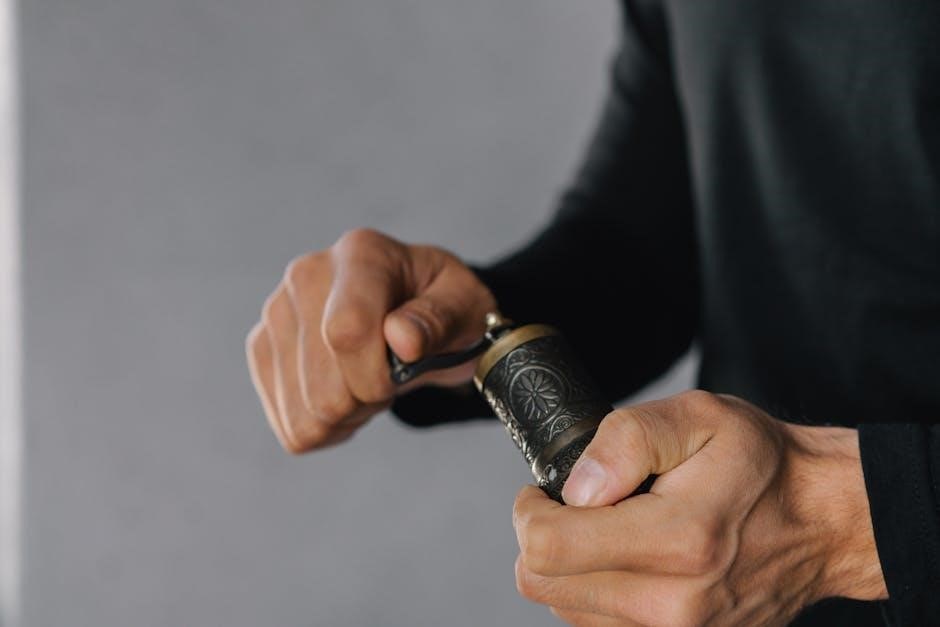Safety Precautions
Always read the manual thoroughly before use. Wear safety glasses‚ gloves‚ and protective clothing. Ensure the area is clear of debris. Avoid loose clothing or jewelry. Operate on stable ground‚ avoiding steep slopes or uneven terrain. Keep children and pets away. Never touch the cutting line or blade while operating. Store the weed eater in a dry‚ secure location out of children’s reach. Ensure proper ventilation when using gas-powered models indoors. Avoid overexertion and take regular breaks. Regularly inspect the equipment for damage or wear. Follow all safety guidelines to prevent accidents and injuries.
1.1 Personal Protective Equipment
Always wear safety glasses or goggles to protect your eyes from debris. Use gloves to maintain a firm grip and prevent blisters. Wear long pants or sturdy clothing to guard against cutting lines or blades. Steel-toe boots or closed-toe shoes are essential to protect feet from heavy objects. Consider ear protection for loud gas-powered models. Ensure no loose clothing or jewelry could get caught in moving parts. Proper PPE reduces injury risks and ensures safe operation of the weed eater.
1.2 Handling Precautions
Operate the weed eater on stable‚ even ground to maintain balance. Avoid overreaching or stretching‚ as this can cause loss of control. Keep the cutting line or blade away from your body and bystanders. Never touch the line or blade while the engine is running. Ensure the area is clear of obstacles‚ pets‚ and children. Use caution when handling sharp or hot components. Proper handling reduces the risk of accidents and ensures smooth operation. Always follow the manufacturer’s guidelines for handling techniques.
1.3 Environmental Safety
Minimize ecological impact by avoiding fuel spills and ensuring proper disposal of waste. Use eco-friendly weed eater options‚ such as electric or manual models‚ to reduce emissions. Avoid trimming near water sources or protected wildlife areas. Maintain the equipment to prevent excessive noise pollution. Always follow local regulations for environmental protection. Properly recycle old batteries and cutting lines to reduce landfill waste. Respect natural habitats while trimming to preserve biodiversity and maintain a balanced ecosystem.

Assembly Instructions
Begin with unboxing and initial setup‚ ensuring all parts are included. Attach the handle securely following the manual. Install the cutting line or blade as instructed for safe operation.
2.1 Unboxing and Initial Setup
Carefully unbox the weed eater and verify all components are included. Read the manual thoroughly to understand safety rules and assembly steps. Inspect the unit for damage or defects. Place the weed eater on a flat‚ stable surface for setup. Remove any packaging materials and protective covers. Familiarize yourself with the controls and features. Ensure the area is clear of debris before proceeding. Prepare the unit for assembly by organizing the provided tools and accessories. Follow the manual’s guidance for proper initial setup to ensure safe and efficient operation.
2.2 Attaching the Handle
Begin by aligning the handle with the weed eater’s main unit‚ ensuring proper fitment. Secure the handle using the provided bolts or knobs‚ tightening firmly. Adjust the handle to a comfortable height for optimal ergonomics. Double-check the connection for stability and durability. Refer to the manual for specific bolt types or torque specifications. Once attached‚ test the handle’s sturdiness by gently tugging on it. Ensure all connections are tight before proceeding to the next step in the assembly process.
2.3 Installing the Cutting Line or Blade
Begin by removing the spool from the weed eater’s head. If using a cutting line‚ feed the line through the spool’s guide‚ leaving equal lengths on both sides. Secure the spool back into place‚ ensuring it clicks firmly. For blades‚ attach the appropriate cutting blade to the arbor bolt‚ tightening it clockwise with the provided wrench. Always refer to the manual for specific line or blade recommendations. Check the line’s tension or blade’s stability before use to ensure proper operation and safety.

Operating the Weed Eater
Hold the weed eater firmly with both hands‚ maintaining control. Start the engine according to your model’s instructions. Engage the cutting mechanism and move steadily‚ trimming in controlled sweeps. Avoid overreaching and keep the blade or line away from hard surfaces to prevent damage.
3.1 Starting the Engine (Gas-Powered Models)
Ensure the area is clear and safe. Prime the engine by pressing the primer bulb 2-3 times until it feels firm. Move the choke to the “start” position. Pull the starter cord firmly with a steady motion until the engine engages. Allow the engine to warm up for a few seconds. Adjust the choke to the “run” position for smooth operation. Always follow the manufacturer’s specific starting procedure for your model.
3.2 Starting the Engine (Electric Models)
Plug the weed eater into a suitable electrical outlet. Ensure the area is clear of debris and obstructions. Wear safety glasses and gloves. Check the power cord for damage before use. Press and hold the safety lock‚ then squeeze the trigger to start the engine. Adjust the handle for comfortable operation. Allow the unit to reach full speed before trimming. Keep the cord away from the cutting line to avoid accidental damage or injury. Always follow the manufacturer’s guidelines for safe operation.
3.3 Basic Trimming Techniques
Hold the weed eater at a 20-degree angle for optimal cutting efficiency. Keep the cutting line parallel to the ground for even results. Use a steady‚ sweeping motion to trim grass and weeds. Avoid applying too much pressure‚ as this can damage the line or blade. For thicker growth‚ work in sections‚ gradually reducing the height. Maintain a consistent pace to ensure uniform trimming. Always keep the cutting head at a safe distance from plants and obstacles to prevent damage. Use the edging guide for precise border work. Regularly inspect the area to ensure all weeds are evenly cut.
3.4 Edging and Precision Trimming
For edging‚ use the guide to create clean borders along sidewalks and gardens. Hold the weed eater at a slight angle to achieve precise lines. Make short‚ controlled passes to avoid over-trimming. For precision trimming around obstacles like trees or flowers‚ reduce the cutting line length and operate at a lower speed. Use a steady‚ vertical motion to trim tight spaces. This ensures accurate cuts and prevents damage to surrounding plants or structures. Regularly inspect edges for consistency and touch up as needed.

Maintenance and Repair
Regularly clean the weed eater to ensure optimal performance. Check and replace worn or damaged parts‚ such as the cutting line or blade. Properly store the equipment in a dry‚ secure location to prevent damage.
4.1 Routine Cleaning
Regular cleaning ensures your weed eater performs efficiently. After each use‚ remove dirt and debris from the exterior and cutting head using a soft brush or cloth. For gas-powered models‚ check the air filter and clean or replace it as needed. Electric models should have their cooling vents wiped down to prevent dust buildup. Lubricate moving parts periodically to maintain smooth operation. Proper cleaning prevents corrosion and extends the tool’s lifespan.
4.2 Replacing the Cutting Line
Regularly replace the cutting line to maintain optimal performance. Turn off the engine and allow the tool to cool. Locate the spool housing and remove the old line. Cut the new line to the recommended length‚ ensuring it matches the manufacturer’s specifications. Thread the line through the spool according to the manual’s instructions. Secure it firmly and test the line feeder to ensure proper operation. Always use the correct type of line for your weed eater model to avoid damage or inefficient cutting.
4.3 Sharpening or Replacing the Blade
Regularly inspect the blade for wear or damage. If dull‚ sharpen it using a file or grinder‚ following the manufacturer’s angle specifications. For severe damage‚ replace the blade entirely. Ensure the new blade is compatible with your weed eater model. Refer to the manual for installation instructions. Always disconnect the spark plug before performing maintenance. Proper blade maintenance ensures efficient cutting and prolongs the tool’s lifespan. Follow safety guidelines during the process to avoid injury.
4.4 Winter Storage Tips
Drain fuel from gas-powered models or store with a full tank to prevent rust. Clean the weed eater thoroughly‚ removing dirt and debris. Store in a dry‚ protected area away from moisture. Cover the blade or cutting line to protect from dust. Avoid extreme temperatures or humidity. Check for damaged parts and repair before storing. Proper winter storage ensures your weed eater remains in good condition for the next season. Follow manual guidelines for specific storage recommendations.

Troubleshooting Common Issues
Address issues like engine failure by checking fuel‚ spark plugs‚ and air filters. Inspect the cutting line for blockages or damage. Sharpen or replace dull blades promptly. Ensure proper assembly and tighten loose parts. Refer to the manual for specific solutions to restore functionality and performance effectively.
5.1 The Engine Won’t Start
If the engine fails to start‚ check the fuel level and ensure it’s the correct type for your model. Verify the spark plug is clean and properly gapped. Inspect the air filter for cleanliness or blockages. Ensure the choke is in the correct position and the throttle is set properly. For electric models‚ confirm the battery is fully charged and connections are secure. If issues persist‚ consult the manual or contact a professional for assistance.
5.2 The Cutting Line Isn’t Feeding Properly
If the cutting line isn’t feeding‚ check if it’s the correct size and type for your model. Ensure the spool is properly wound and aligned. Remove any debris or tangles from the spool housing. Gently tap the spool to release the line. For automatic feed models‚ advance the line by bumping the spool on the ground. If manual feeding is required‚ stop the engine and pull out additional line. Refer to your manual for specific instructions to resolve the issue effectively.
5.3 The Blade Is Dull or Damaged
If the blade is dull or damaged‚ stop use immediately. Wear protective gloves and eyewear. Inspect the blade for nicks‚ dents‚ or wear. Use a file or sharpening stone to restore sharpness if dull. For damaged blades‚ replace with a compatible part from the manufacturer. Ensure proper installation and alignment. Regular maintenance prevents premature wear. Always follow safety guidelines when handling blades to avoid injury. Proper care extends blade life and ensures efficient performance. Refer to your manual for specific blade care instructions.

Accessories and Attachments

Explore various cutting lines‚ such as round or square lines‚ for different tasks. Optional attachments like edging blades or brush cutters enhance versatility for precision trimming and thicker vegetation.
6.1 Types of Cutting Lines
Choose from various cutting lines‚ including round‚ square‚ or twisted designs‚ each offering different cutting efficiency and durability. Round lines are ideal for light weeds‚ while square lines cut thicker vegetation effectively. Twisted lines minimize noise and vibration. Select lines compatible with your weed eater model for optimal performance. Refer to your manual for recommended line thickness and type. Using the correct line ensures safety and extends equipment lifespan. Always follow manufacturer guidelines for best results.
6.2 Optional Attachments for Versatility
Enhance your weed eater’s functionality with optional attachments like brush cutter blades‚ edging wheels‚ or hedge trimmer heads. These attachments allow you to tackle thicker weeds‚ precision-edge lawns‚ or trim hedges with ease. Brush cutter blades are ideal for heavy-duty clearing‚ while edging wheels provide clean‚ precise borders. Hedge trimmer attachments enable versatile yard maintenance. Always ensure compatibility with your model and follow installation guidelines for safe‚ effective use. Expand your tool’s capabilities with these practical additions.

Understanding Different Types of Weed Eaters
Weed eaters come in gas-powered‚ electric‚ and manual models. Gas-powered offers high power for heavy tasks‚ while electric models are eco-friendly and quieter. Manual types are lightweight and budget-friendly.
7.1 Gas-Powered Weed Eaters
Gas-powered weed eaters are ideal for heavy-duty tasks and large areas. They offer high power and efficiency‚ making them suitable for cutting thick weeds and brush. These models typically feature durable engines and adjustable handles for comfort. They are often preferred by professionals due to their reliability and performance. However‚ they require regular maintenance‚ such as oil changes and filter cleaning. Gas-powered weed eaters are versatile and can be equipped with metal blades for tougher jobs.
7.2 Electric Weed Eaters
Electric weed eaters are eco-friendly and cost-effective alternatives to gas-powered models. They operate quietly‚ produce zero emissions‚ and require minimal maintenance. These models are lightweight and easy to maneuver‚ making them ideal for smaller yards and precision trimming. Corded electric weed eaters provide consistent power but limit mobility‚ while cordless models offer greater versatility. They are suitable for light to moderate weed control and are a popular choice for environmentally conscious homeowners seeking efficient‚ hassle-free yard maintenance solutions.
7.3 Manual (Push) Weed Eaters
Manual or push weed eaters are non-motorized tools ideal for small-scale yard maintenance. They rely on physical effort‚ making them eco-friendly and cost-effective. These tools are perfect for light weeding and precision trimming in tight spaces. They are often used for edging and small gardens. Manual weed eaters are quiet‚ emit no fumes‚ and require minimal maintenance. While they demand more physical effort‚ they are a sustainable and budget-friendly option for homeowners with limited yard space or light weed growth.

Advanced Trimming Techniques
Master advanced techniques like maintaining steady pace‚ precise angle control‚ and optimal cutting line length. These methods enhance efficiency and prevent damage to plants and tool.
8.1 Trimming Thick or Overgrown Weeds
For tackling thick or overgrown weeds‚ use a metal blade or heavy-duty cutting line. Maintain a steady pace and keep the blade at a 30-degree angle. Apply gentle pressure to avoid damaging the tool. Work in small sections‚ cutting from the base upwards. Regularly clear debris to maintain visibility. Overgrown areas may require multiple passes for complete removal. Monitor progress to ensure efficient trimming without overloading the machine.
8.2 Precision Trimming Around Obstacles
Use a shorter cutting line or a precision blade for better control. Angle the weed eater slightly to navigate tight spaces around plants‚ fences‚ or garden features. Move slowly and carefully‚ keeping the blade a few inches away from obstacles to prevent damage. Use the edge guide for straight lines along borders. For delicate areas‚ reduce the engine speed or use a manual feed option. This ensures precise trimming without harming surrounding plants or structures‚ achieving a clean‚ professional finish.

Environmental Considerations
Choose eco-friendly weed eater models‚ such as electric or battery-powered options‚ to reduce emissions. Properly dispose of old equipment and chemicals to prevent environmental harm. Opt for energy-efficient operation and regular maintenance to minimize ecological impact while maintaining performance.
9.1 Eco-Friendly Weed Eater Options
Consider eco-friendly weed eater options to minimize environmental impact. Electric and battery-powered models reduce emissions and energy consumption. Manual push weed eaters are another sustainable choice‚ eliminating the need for fuel or electricity. These options are quieter‚ produce fewer emissions‚ and are more energy-efficient. They are ideal for small to medium-sized yards and help reduce carbon footprint. Opting for eco-friendly models supports environmental conservation while maintaining effective weed control.
9.2 Proper Disposal of Old Weed Eaters
Properly dispose of old weed eaters by following local regulations. Separate components like batteries‚ metal‚ and plastic for recycling. Check local recycling centers or hazardous waste facilities for guidance. Do not dispose of gas-powered models in regular trash due to potential environmental harm. Drain fuel and oil responsibly. Battery-powered units require safe battery disposal to prevent contamination. Ensure all parts are handled correctly to minimize environmental impact and promote sustainable waste management practices.
10.1 Summary of Key Points
Always prioritize safety‚ wearing protective gear and following manual guidelines. Regular maintenance ensures longevity and efficiency. Use appropriate cutting lines and blades for different tasks. Opt for eco-friendly options when possible. Store equipment properly and dispose of old models responsibly. For complex issues‚ consult troubleshooting guides or professional resources. By adhering to these principles‚ you’ll maximize performance and safety while maintaining your outdoor spaces effectively.
10.2 Additional Resources for Further Learning
For in-depth knowledge‚ visit official manufacturer websites like Weed Eater or STIHL for detailed guides. ManualsLib offers over 1‚225 manuals for various models. YouTube features repair tutorials and maintenance tips. Download PDF guides for specific models‚ such as the Weed Eater 320iL or STIHL FSA 57. Explore forums and community discussions for user experiences and troubleshooting advice. Refer to local hardware stores or authorized service centers for professional assistance and genuine parts.
